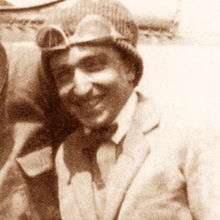Fortunato Depero
Italian painter, writer, sculptor and graphic designer (1892-1960)
Fortunato Depero (March 30, 1892 – November 29, 1960) was an Italian futurist painter, writer, sculptor and graphic designer.

Quotes
edit- We Futurists, Balla and Depero, seek to realize this total fusion in order to reconstruct the universe by making it more joyful, in other words by an integral re-creation. 'We will give skeleton and flesh to the invisible, the impalpable, the imponderable and the imperceptible. We will find abstract equivalents for all the forms and elements of the universe, and then well will combine them according to the caprice of our inspiration, to shape plastic complexes which we will set in motion.
- The Futurist Reconstruction of the Universe Manifesto with Giacomo Balla, in: Direzione del Movimento Futurista, March 11, 1915. Translation by Caroline Tisdall, 1973.
- The art of the future will be largely advertising.
that bold and unimpeachable lesson I have learned from museums and great works from the past—
all art for centuries past has been marked by advertising purposes: the exaltation of the warrior, the saint; documentation of deeds, ceremonies, and historical personages depicted at their victories, with their symbols, in the regalia of command and splendor—
even their highest products were simultaneously meant to glorify something: architecture, royal palaces, thrones, drapery, halberds, standards, heraldry and arms of every sort—
there is scarcely an ancient work that doesn’t have advertising motifs, a garland with a trophy, with weapons of war and victory, all stamped with seals and the original symbols of clans, all with the self-celebrating freedom of ultra-advertising- Depero (1931) "Futurism and Adverticing Art"; Partly quoted in: Jonathon Keats, "Fortunato Depero's Italian Futurism," forbes.com, 2009/06/08
- The Futurists were the first painters, poets, and architects who exalted modern work with their art—
- they painted speeding automobiles—
- they painted lamps bursting with light—
- they painted steaming locomotives and swift bicyclists—
- the Futurists stylized their compositions, adopting a violently colored look; with synoptic and geometric shapes they multiplied and decomposed the rhythms of objects and landscapes in order to increase their dynamic qualities and to give an effective rendering of their swift ideas, the states of mind, their conceptions.
- Depero (1931) "Futurism and Adverticing Art"; Republished in: Futurism : an anthology. edited by Lawrence Rainey, Christine Poggi, and Laura Wittman, (2011), p. 290
So I think, so I paint (1947)
editFortunato Depero, So I think, so I paint: ideologies of an Italian self-made painter, Mutilati e Invalidi, 1947.
- Futurism attracted me and made me better, gave me a new strength, showed me new fields and possibilities.
- p. 14; Cited in: Maurizio Scudiero, David Leiber, Fortunato Depero (1986) Depero futurista & New York: il futurismo e l'arte pubblicitaria, p. 112
- The first and foremost critic of a work of art is the artist who created it. Give him every means to illustrate it and make it known. If an artist awaits celebrity or gratefulness for his work through other people, he will have the time to die a thousand times for sheer hunger.
- p 97.
- If a painter once devoted himself to dynamism and now abandons it, denies it and even criticizes it, it is his own business. This does not mean, however that futurism has had his day. It is always worthy of interest and many artists still work in its ranks with unchanged passion. Dynamism is in life and in nature itself.
- p. 112
Quotes about Deparo
edit- [Depero] did not differentiate between ‘major’ and ‘minor’ arts, putting all on the same level.
- Gabriella Belli, quoted in: Jonathon Keats, "Fortunato Depero's Italian Futurism," forbes.com, 2009/06/08
- His playful imagination found expression in the series of Plastic Dances (balli plastici) which he designed in 1917 and produced the next year at the Teatro dei Piccoli (Children’s Theater) in Rome. During the 1920s he designed exhibition booths and pavilions for various firms and events. Depero was in Paris from 1925 to 1926, then in New York from 1928 to 1930 when he designed covers for Vanity Fair, Vogue, and other magazines. Many of his designs were for the Campari company, and he theorized this work in “Futurism and Advertising Art”
- Futurism : an anthology. edited by Lawrence Rainey, Christine Poggi, and Laura Wittman, (2011), p. 511-2
- In his own paintings, Depero depicted a fantastic world of vegetal, animal and mechanical forms, in a dynamic synthesis of large, flat areas of bright color. In 1919 he founded the Casa d'Arte Futurista in Rovereto, where he produced furniture, objects, graphics, posters and tapestries, with his wife Rosetta. During the 1920s Depero spent some months in Paris, where he showed in the Italian pavilion of the Exposition Internationale des Arts Decoratifs et Industriels Modernes, with Balla and Prampolini. Depero experimented with built structures designed out of letters-what he termed "typographical" or "advertising architecture."
- Hangar Design Group. Fortunato Depero. Peggy Guggenheim Collection. Retrieved on June 4, 2014.